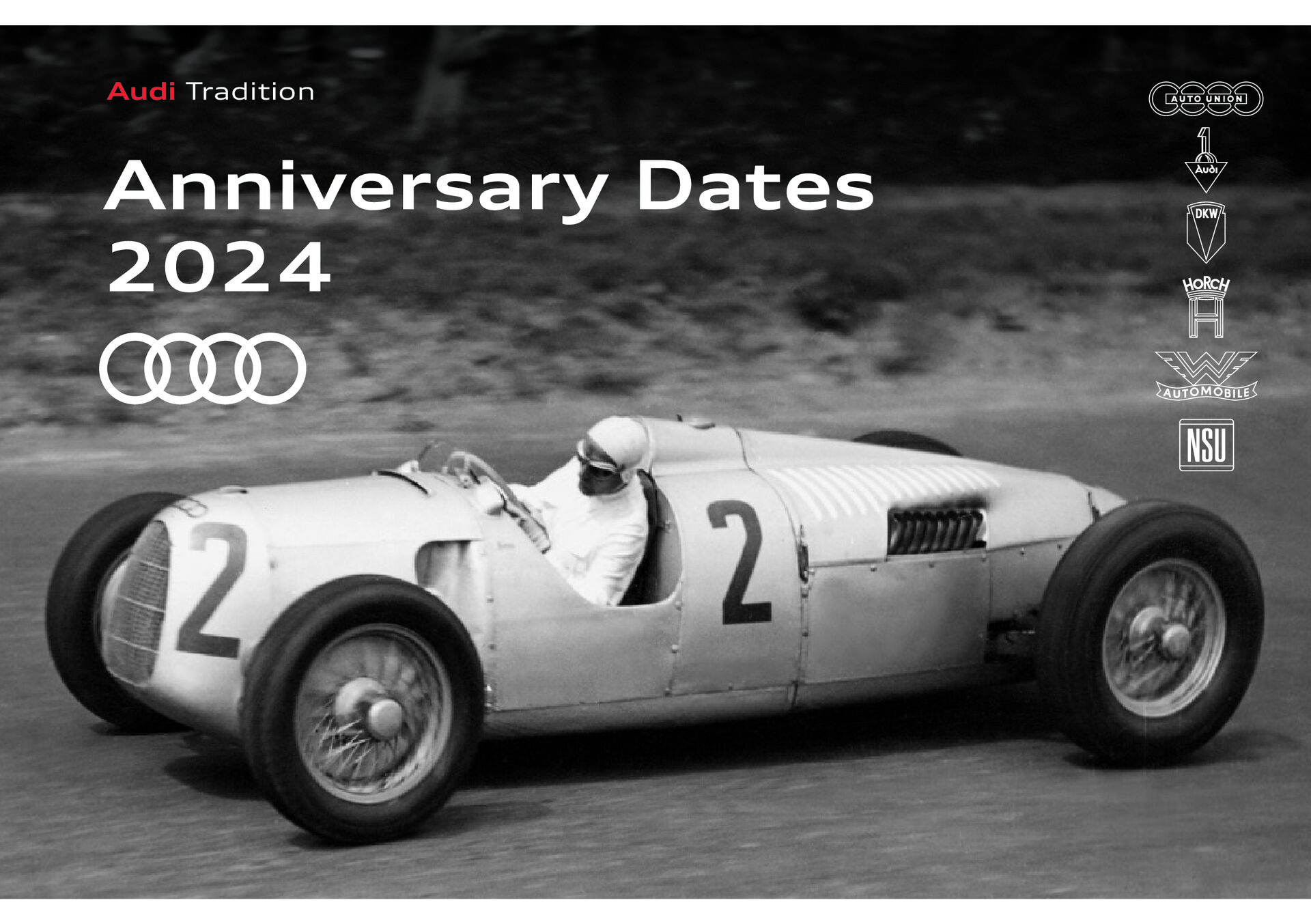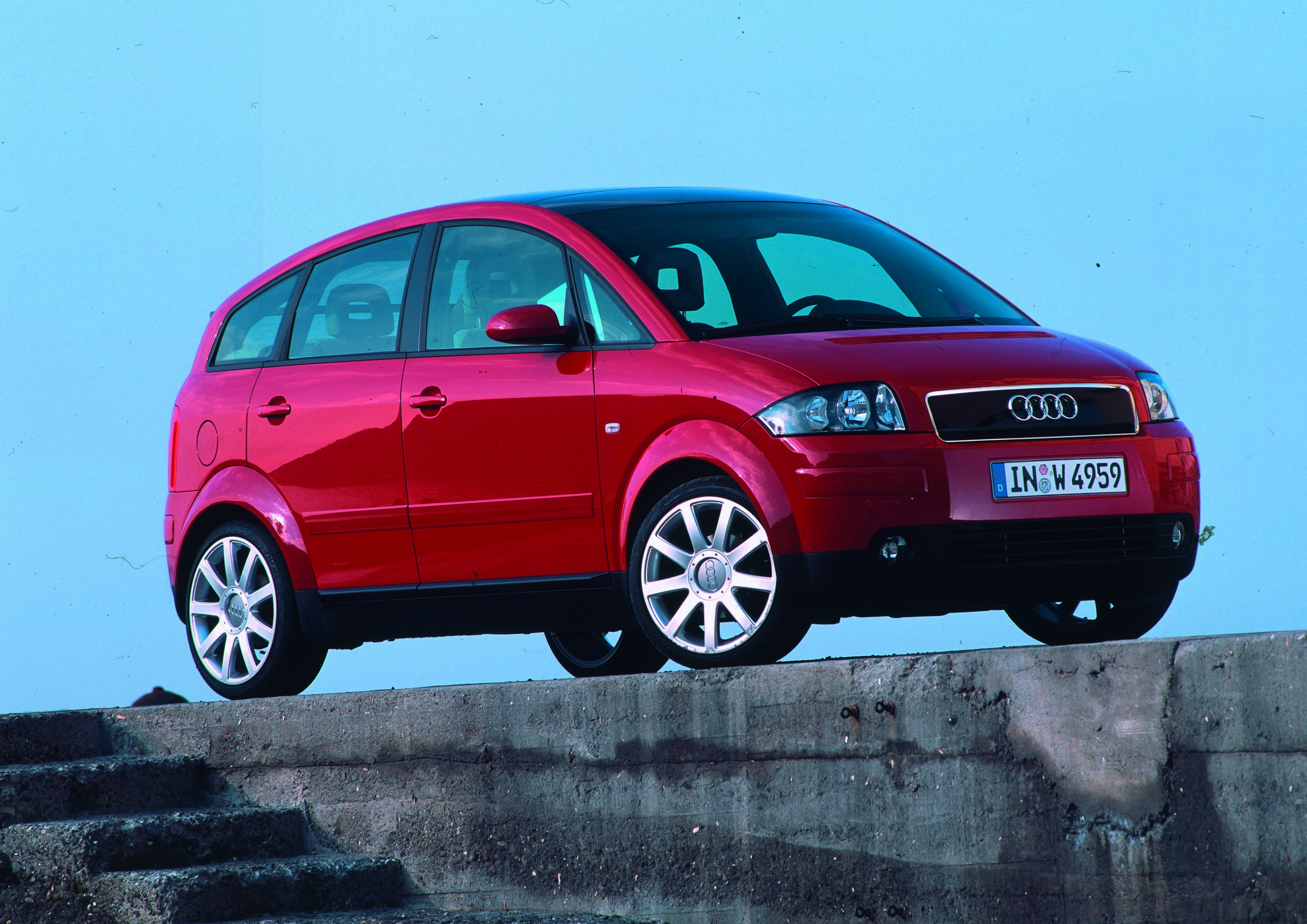Search
All search results for "audi a2 100 years audi"
(15)
 History
History
1873 Christian Schmidt and Heinrich Stoll establish a workshop for the production of knitting machines in Riedlingen on the Danube. 1880 The company relocates to Neckarsulm 1886 Bicycle production begins 1900 Motorcycle production begins 1906 Production of automobiles begins (“Original Neckarsulmer Motorwagen”) 1928 Automobile production ends and the factory in Heilbronn is sold 1933 Ferdinand Porsche commissioned to build the NSU/Porsche Type 32, the VW Beetle’s predecessor 1945 Part of the plant is destroyed in World War II; production gradually resumes beginning in mid-1945 1955 NSU Werke AG is the world’s largest motorcycle plant 1958 Automobile production resumes with the NSU Prinz I to III 1964 Production of the NSU/Wankel Spider, the world’s first production car with a rotary piston engine, begins 1967 Series production of the NSU Ro 80 begins; due to its futuristic design and rotary piston engine, it is voted “1968 Car of the Year” 1969 Merger with Auto Union GmbH Ingolstadt to become Audi NSU Auto Union AG; the majority shareholder is Volkswagen AG 1974/75 The site is threatened with closure during the oil crisis.
 Audi Tradition to commemorate numerous anniversaries in 2025
Audi Tradition to commemorate numerous anniversaries in 2025
Booklet features a selection of more than two dozen anniversaries The launch of the Audi A2 25 years ago; the first new Audi in post-war times 60 years ago; and Hans Stuck’s record-breaking exploits in the “world’s fastest road-going car” near Lucca 90 years ago
With the “Anniversary Dates 2025” booklet, Audi Tradition is showcasing the most important moments in the product and company history of Audi, which is as eventful as it is diverse. Audi historians have selected a total of 27 dates to commemorate in 2025.
Twenty-five years ago, the Audi A2 hit the market. With its aluminum body, it made a name for itself as a progressive compact car: light, aerodynamic, and economical. The Audi A2 polarized opinion with its design and unusual proportions; the concept was ahead of its time. However, sales remained below expectations, and Audi ended production after roughly five years and 176,377 units built. Since then, the A2 became a fan favorite and is now a sought-after collector’s item. Sixty years ago, the first post–World War II Audi rolled off the production line. With the “Auto Union Audi” vehicle, Auto Union GmbH revived the tradition-steeped Audi brand name in 1965. The new name was meant to show that this car represented a fresh start for Auto Union in terms of technology. The Audi was the first car from the brand with four rings to feature a four-cylinder four-stroke engine, and it marked the beginning of a new era in Ingolstadt. Twenty years later, on January 1, 1985, Audi NSU Auto Union AG was renamed AUDI AG, and since that time, the company and its products have shared the same short, memorable name. Ninety years ago, in February 1935, a spectacular attempt to break speed records took place in Italy. After test drives in October 1934 with the Grand Prix racing car on the AVUS in Berlin, the Auto Union racing department started developing the vehicle that would later be known as the “Lucca” car.
 Audi Tradition - Anniversary Dates 2025
Audi Tradition - Anniversary Dates 2025
Anniversary Dates 2025 Audi Tradition 2 Anniversary Dates 2025 Contents Anniversaries in Our Corporate History May 2000 25 years Market Launch of the Audi allroad quattro ....5 June 2000 25 years Sales Launch of the Audi RS 4 B5 ...............6 June 2000 25 years Market Launch of the Audi A2 ..................... 7 December 2000 25 years Audi museum mobile Ingolstadt ................9 March 1990 35 years Presentation Audi duo .............................10 September 1990 35 years First Appearance Audi Coupé S2...............11 January 1985 40 years Renaming of Audi NSU Auto Union AG to AUDI AG ..........................................................12 Autum 1985 40 years Audi Introduces Fully Galvanized Bodies in Mass Production ...............................................13 February 1980 45 years Audi 200 5T – Audi’s First Turbocharged Petrol Engine .......................................................14 Oktober 1975 50 years Audi 80 GTE ...........................................15 End of 1975 50 years Start of Porsche 924 Production in Neckarsulm ......................................................16 Oktober 1970 55 years Market Launch of the Audi 100 Coupé S ....17 September 1965 60 years Reintroduction of the Audi Brand ..............18 1965 60 years NSU Prinz 1000 TT and NSU Typ 110 ........ 20 September 1955 70 years Large DKW 3=6 ....................................... 22 Audi Tradition 3 Anniversary Dates 2025 End of 1955 70 years DKW Plastic Bodies .................................. 23 August 1950 75 years First DKW Passenger Car After the War ..... 25 December 1945 80 years Establishment of the Central Depot for Auto Union Spare Parts in Ingolstadt ................ 26 February 1935 90 years Introduction of the Horch 850 Series ........ 27 February 1935 90 years Roadster Models of 1935......................... 28 Audi Tradition 4 Anniversary Dates 2025 Contents Motorsport 2000 25 years Audi’s First Victory at Le Mans .................. 30 1990 35

Successful for decades: 662,762 units across three generations built over 25 years Design inspired by Bauhaus: every shape has a clear function Vorsprung durch Technik: New technologies launched with the TT, including Audi magnetic ride, Audi virtual cockpit, and OLED technology
A quarter of a century of TT history: When Audi presented the concept car at the IAA in 1995, public opinion became clear right away: “This car should be mass-produced – exactly as it is!” With the series debut in 1998, the Audi TT wrote design history and was built across three generations as a Coupé and Roadster.
With a vision of “a car for enthusiasts,” Audi presented the Audi TT Coupé as a sports car concept at the IAA in Frankfurt in the fall of 1995. Shortly afterward, the decision was made to mass-produce it. Torsten Wenzel, the exterior designer at Audi who helped introduce the study to series production, recalls: “To us, the greatest praise was when the trade press noted appreciatively that not much had changed from the concept to production model, although we did, of course, have to adapt many details due to the technical specifications for the production version, including the proportions.” Most noticeable was the integration of a rear side window, which elongated the car’s profile and increased the sports car’s dynamics. For Wenzel, the TT remains “a driving sculpture, with highest-quality surfaces and lines.” The body of the Audi TT appears to be made from one piece, Wenzel says, and the front end without traditional bumper overhangs emphasizes its distinctive shape. Another design element contributes to the unmistakable silhouette of the Audi TT Coupé: the circle – “the perfect graphic shape,” as Wenzel describes it. Numerous circular elements inspired the sports car’s exterior and interior design. Inspired by Bauhaus, every line in the Audi TT has a purpose, every shape a function. “At Audi Design, we always follow the philosophy of ‘less is more.’
 Combined Annual and Sustainability Report 2024
Combined Annual and Sustainability Report 2024
Advances in ESG factors can also be achieved in the supply chain thanks to the use of a Group-wide sustainability rating for suppliers. ¹ Audi Q7: fuel consumption (weighted combined): 12.7–1.2 l/100 km; electric power consumption (weighted combined): 29.1–27.8 kWh/100 km; CO₂ emissions (weighted combined): 289–28 g/km; CO₂ class (weighted combined): G–B; fuel consumption with empty battery (combined): 10.5–9.8 l/ 100 km; CO₂ class with empty battery: G. ² Audi Q8: fuel consumption (weighted combined): 13.6–1.2 l/100 km; electric power consumption (weighted combined): 30.4–27.7 kWh/100 km; CO₂ emissions (weighted combined): 310–27 g/km; CO₂ class (weighted combined): G–B; fuel consumption with empty battery (combined): 10.9–9.8 l/ 100 km; CO₂ class with empty battery: G. ³ Lamborghini Urus: fuel consumption (weighted combined): 14.9–2.1 l/100 km; electric power con- sumption (weighted combined): 39.5 kWh/100 km; CO₂ emissions (weighted combined): 320–51.3 g/km; CO₂ class (weighted combined): G–B; fuel consumption with empty battery (combined): 12.9 l/100 km; CO₂ class with empty battery: G. ⁴ Audi e-tron GT: electric power consumption (combined): 21.1–18.0 kWh/100 km; CO2 emissions (combined): 0 g/km; CO2 class: A. ⁵ Lamborghini Temerario: Data on CO₂ emissions and fuel consumption for EU27 are still pending, subject to EU type approval.
 After “Windschnittig” comes “Form vollendet”: A new special exhibition at the Audi museum mobile
After “Windschnittig” comes “Form vollendet”: A new special exhibition at the Audi museum mobile
Aerodynamics in automotive manufacturing from 1945 to the present day: from concept cars and record-breaking models to race cars and the Cd world champion, the Audi 100 Almost 30 exhibits feature in a special exhibition from July 25, 2024, to March 2, 2025
Audi wrote engineering history in 1982 with the Audi 100. With its drag coefficient of 0.30, the third-generation Audi 100 was the world’s most aerodynamically efficient production saloon at the time, making it an essential part of the new special exhibition "Form vollendet". The new special exhibition will be at the Audi museum mobile in Ingolstadt until March 2, 2025, where Audi Tradition will present aerodynamic concepts from 1945 to the present day.
The aerodynamics research that flourished before the Second World War and which was the subject of Audi Tradition’s “Windschnittig” exhibition (German for “streamlined”) that ran until the end of June received little attention after 1945. Europe’s automotive industry was busy getting back on its feet. During this period, pre-war developments were still in use and improved upon. It wasn’t until the rising cost of fuel during the 1973 oil crisis prompted a shift in thinking that automotive engineers began focusing on reducing fuel consumption. One of the dials used to achieve this was aerodynamic drag. In 1982, Audi made a splash with the Audi 100; its drag coefficient of 0.30 set a world record for production sedans, a value that would become the benchmark for years to come. The new Audi Tradition special exhibition “Form vollendet” (German for “form perfected”) showcases the Cd world champion Audi 100 alongside other models such as the NSU Ro 80, the Porsche 356, the Lamborghini Countach, and the Ducati Paso 950.
 Audi Tradition - Anniversary Dates 2024
Audi Tradition - Anniversary Dates 2024
Anniversary Dates 2024 Audi Tradition Audi Tradition 2 Anniversary Dates 2024 Contents Anniversaries in Our Corporate History March 1999 25 Years Audi S3 ....................................................5 October 1994 30 Years Audi A4 ...................................................6 June 1994 30 Years Audi A6 ....................................................7 March 1994 30 Years Audi A8. ...................................................8 1994 30 Years Since Market Launch of Avant RS2 .............9 Autumn 1989 35 Years Audi duo ................................................10 Autumn 1989 35 Years of Audi Turbo-Diesel With Direct Fuel Injection (TDI) .....................................11 April 1984 40 Years Audi Sport quattro ..................................12 October 1974 50 Years Audi 50 ..................................................13 September 1969 55 Years Audi 100 Coupé S ....................................14 March 1969 55 Years Audi NSU Auto Union AG .........................15 March 1969 55 Years NSU K 70 ................................................16 December 1964 60 Years Since Takeover of Auto Union GmbH by Volkswagenwerk AG .........................................18 March 1964 60 Years DKW F 102 ............................................19 January 1964 60 Years DKW F 12 Roadster ................................20 Audi Tradition 3 Anniversary Dates 2024 August 1959 65 Years Since Start of Production of DKW Junior ...21 August 1959 65 Years Since Commissioning of New Factory .......23 September 1949 75 Years Since Founding of Auto Union GmbH, Ingolstadt ...........................................................24 September 1949 75 Years DKW Schnelllaster and RT 125 W .............25 1899 125 Years Since August Horch Founded His First Company ................................................27 Audi Tradition 4 Anniversary Dates 2024 Contents Motorsport June 1999 25 Years Le Mans ..................................................28
 The most high-performance models of all time from Audi
The most high-performance models of all time from Audi
In 2019, Audi Sport GmbH (formerly known as quattro GmbH) launched its largest RS model offensive within a year and thus offers the largest product portfolio of all time.
